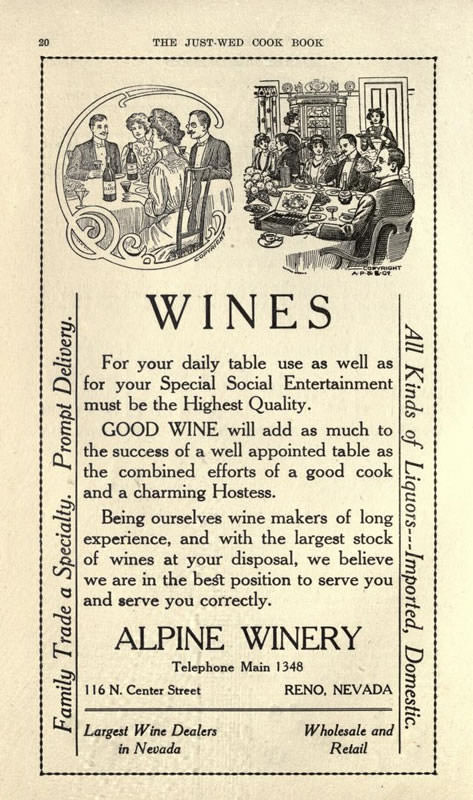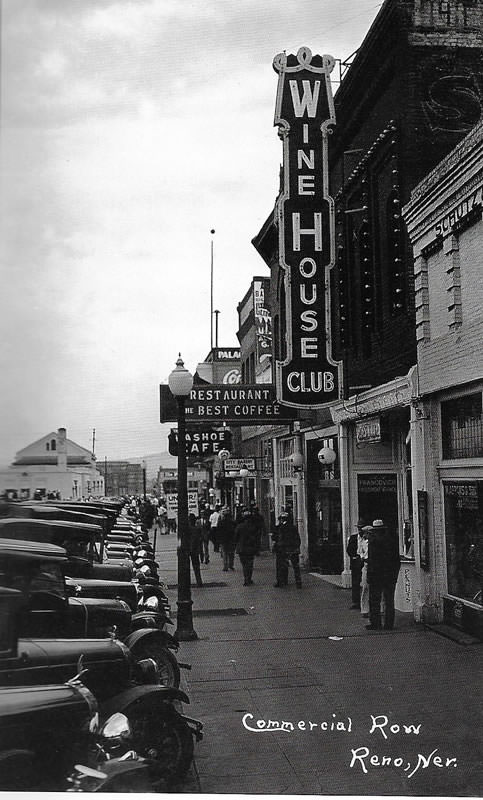edible traditions
CRUSHING THE ODDS
The history of vino in Reno
WRITTEN BY SHARON HONIG-BEAR
Sierra Wine & Liquor Co. was where the old railway headquarters were housed.
Now the building is The Depot Craft Brewery Distillery. Photo courtesy of National Trust of Historic Places
In a case of what’s old is new again, wineries are woven into the tapestry of Reno’s past (see article on Nevada’s first urban winery). Nevadans always have enjoyed wine, despite the challenges of growing good fruit in the state. Instead, the Silver State’s wine history involves bottling, blending, selling, and distributing the mighty grape.
Railroad cars of grapes
The early winemakers brought their grapes from California to Reno by railroad car. In 1901, Felix Vigliotto, reported to be the proprietor of the only winery in Nevada, received a carload of grapes from Colfax. Two years later, Fred Marra obtained five carloads of grapes for his winery. By 1906, Marra increased his haul to eight carloads, particularly for making brandy. The headline in a 1903 Reno Evening Gazette proclaimed a “New Industry” when A.T. Dormio shipped in “mountains of grapes for his new winery on Peavine Street.”
Prohibition takes its toll
Alpine Winery burst on the scene in 1912. It proclaimed to “make our own wines at Santa Rosa, Calif., and can guarantee their purity,” addressing the fact that liquor often was contaminated in those pre-Prohibition times. Alpine was owned by prominent Reno businessmen Edward and Caesar Vachina. The winery finally settled at 116 N. Center St. in Reno in 1914.
In the early 1920s, Alpine Winery was a regular stop for Prohibition agents. “Alpine Winery is raided once again,” rang out the headline in the April 26, 1923 Nevada State Journal. “It became necessary to use force in securing entry through the two doors and during the melee a well-known politician is said to have fallen unconscious from fright.”
After Prohibition, the site was reborn as the Alpine Club and then renamed the 116 Club. Winemaking days were over, but the club emerged as a center for Reno social life, attracting the elite of Reno society.
 Alpine Winery ad from The Just-Wed Cook Book
Alpine Winery ad from The Just-Wed Cook Book
Gangster connections
The year 1934 was a big one for Bernardino and Pierino Barengo. They opened Sierra Wine & Liquor Co., which also handled bulk wines from the Barengos’ own winery in Galt, Calif. They also brought wine from Acampo Winery in the Lodi area and labeled it Barengo Wine. Also in 1934, Reno’s underbelly came into the light with the mob-related disappearance of banker Roy Frisch. The gangster mix included George “Baby Face” Nelson and John Dillinger. Pete Barengo was called to testify in New York as a character witness at the famed trial of William “Bill” Graham and James “Jim” McKay. He left Reno by train with gaming pioneers Nathan “Nick” Abelman and Steve Pavlovich. The book Mob City states, “They traveled in style, each armed with pistols in shoulder holsters.”
Despite these rough beginnings, the liquor business thrived, and in 1958, Thelma and Pete Barengo bought the closed Nevada-California-Oregon Depot and operated it for decades.

Exterior shot of Wine House Club. Photo courtesy of Jerry Fenwick
Legendary spot
The granddaddy of Reno restaurants and saloons would have to be the Wine House Club. Founded in 1874 by Eli Francovich, who had emigrated from Yugoslavia to Reno, it commanded a prominent location on Commercial Row and stood for more than 80 years as a leading spot for locals and visitors. In the early years, barrels of wine were displayed prominently in the saloon, along with bottled spirits. Like most other businesses, it was involved in repeated indictments during Prohibition. Although the Wine House became a soft-drink establishment, alcoholic drinks were served via the back door. One of its many legal tangles made it all the way to the U.S. Court of Appeals for the Ninth Circuit.
The names of the wineries have faded, but there is one legend that lives on. Search out a bottle of the potently delicious holiday nog marketed under the name Francovich (only available during the winter holidays), and you are connected to the Wine House and the early days of Reno wineries and saloons.
Sharon Honig-Bear was the long-time restaurant writer for the Reno Gazette-Journal. She is a tour leader with Historic Reno Preservation Society and founder of the annual Reno Harvest of Homes Tour.
From left, Jan Solberg, Brenda Horton, Susan Hamarlund, and Sue Higgins of the Ladies Auxiliary of the Fleet Reserve Association serve muffins to veterans at Carson City’s Veterans Memorial Hall


